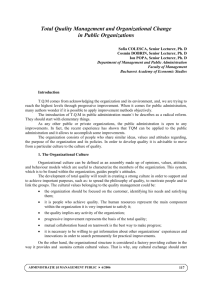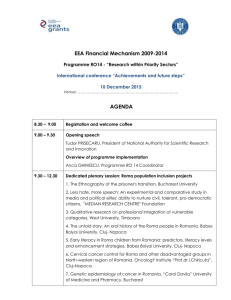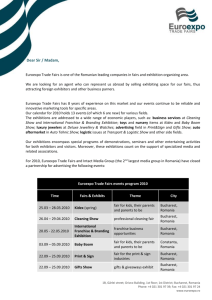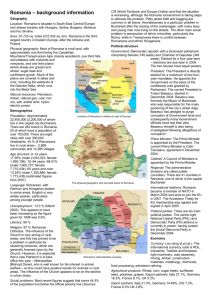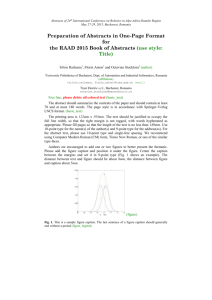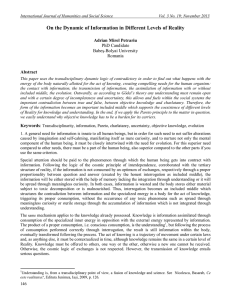Motivation - A Stimulating Factor for Increasing Human Resource Management Performance
advertisement
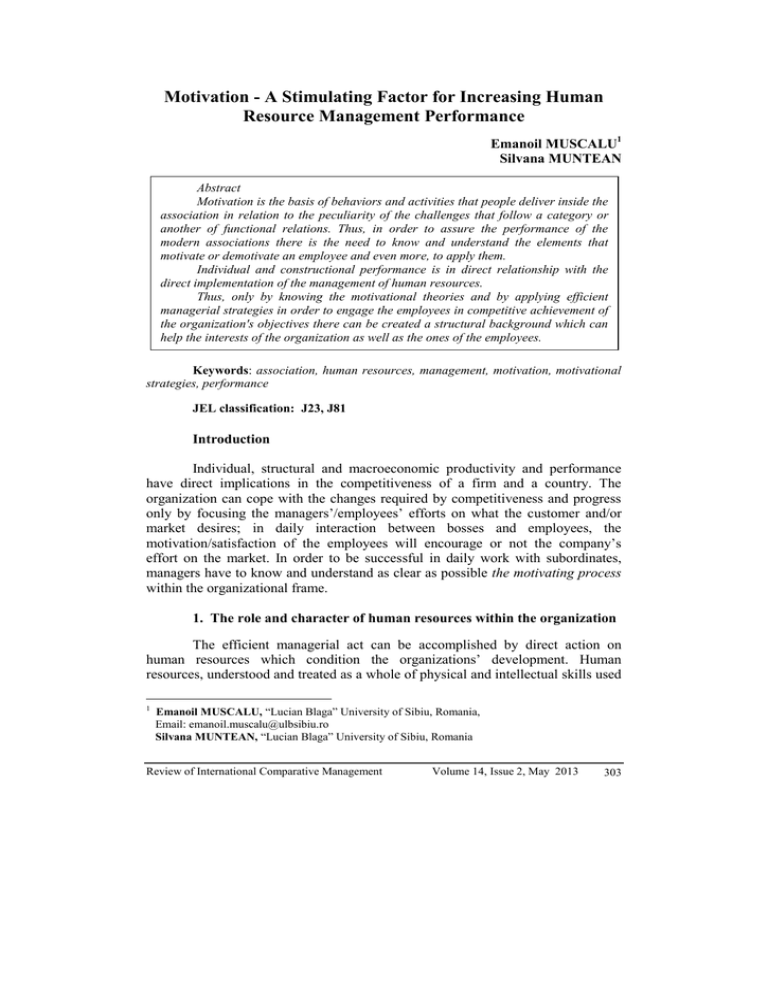
Motivation - A Stimulating Factor for Increasing Human Resource Management Performance Emanoil MUSCALU1 Silvana MUNTEAN Abstract Motivation is the basis of behaviors and activities that people deliver inside the association in relation to the peculiarity of the challenges that follow a category or another of functional relations. Thus, in order to assure the performance of the modern associations there is the need to know and understand the elements that motivate or demotivate an employee and even more, to apply them. Individual and constructional performance is in direct relationship with the direct implementation of the management of human resources. Thus, only by knowing the motivational theories and by applying efficient managerial strategies in order to engage the employees in competitive achievement of the organization's objectives there can be created a structural background which can help the interests of the organization as well as the ones of the employees. Keywords: association, human resources, management, motivation, motivational strategies, performance JEL classification: J23, J81 Introduction Individual, structural and macroeconomic productivity and performance have direct implications in the competitiveness of a firm and a country. The organization can cope with the changes required by competitiveness and progress only by focusing the managers’/employees’ efforts on what the customer and/or market desires; in daily interaction between bosses and employees, the motivation/satisfaction of the employees will encourage or not the company’s effort on the market. In order to be successful in daily work with subordinates, managers have to know and understand as clear as possible the motivating process within the organizational frame. 1. The role and character of human resources within the organization The efficient managerial act can be accomplished by direct action on human resources which condition the organizations’ development. Human resources, understood and treated as a whole of physical and intellectual skills used 1 Emanoil MUSCALU, “Lucian Blaga” University of Sibiu, Romania, Email: emanoil.muscalu@ulbsibiu.ro Silvana MUNTEAN, “Lucian Blaga” University of Sibiu, Romania Review of International Comparative Management Volume 14, Issue 2, May 2013 303 by man in the process of production of material goods necessary for existence, represent a concept that aims both technical-economic and social-historical elements. As it can be seen, modern society is presented as a network of organizations that appear, develop or disappear. In these circumstances, people are a vital resource of today and tomorrow, of all the organizations that ensure their survival, development and competitive success. This reality or truth has determined many specialists to say that "The organization’s competitive advantage lies more and more in its people” Investing in people has proved to be the surest way to guarantee the survival of an organization, or to certify its competitiveness and its future. In the new informational society the human capital has replaced the financial one, as a strategic resource. If we analyze the human influence, in a larger context, we notice that the work and especially the modern economy tend to become, progressively, more impersonal. This is not for subjective reasons, but especially for objective ones dictated by the economical efficiency in an environment where the competition is growing stronger and stronger, where everyone can produce more and better and a lot of high technologies become available for business, it is absolutely normal to prevail efficiency in terms of human resources too (individual growth, one's personal matters, strictly individual preferences, with rare exceptions, are important for modern organizations, except for charitable ones, as long as the individual clearly proves that he can efficiently and effectively work for the organization's interest). Policy and strategies in human resources management Management of human resources, is differentiated and automated, within the general management frame, limiting its matter of exploration or its object of study and, consequently, specialized having its specific place in general management. Human Resources Management represents that specialized area of general management of organization in which the matter of personnel is approached in a holistic, globalist, interdisciplinary and professional vision and which stays in accomplishing the organization`s objectives by recruiting, selecting, developing and appropriate use of its human resources so that the professional and creative potential of all members can be wholly shown off. Thus, any organization can have a very well defined strategy and policy in the domain of human resources management. Policy in the human resources management composes as a system of objectives, principles, methods and work criteria with the personnel of the company, which is common for all the employees. We appreciate that in human resources management the content of the policy materializes in: • assurance with highly qualified labor power; • training and increasing of personnel's qualification; • high motivation of the personnel; 304 Volume 14, Issue 2, May 2013 Review of International Comparative Management • assurance of proper working conditions; • promoting of young employees. Within the policy of human resources management a distinct place has its strategies which arrange upon well determined criteria, among which we recall: According to the degree of dependency on the company strategy: • value-oriented staff strategy takes into account the basis requirement which consists in respecting the staff's interests, wishes or aspirations simultaneous with proper using of their potential; • resource-oriented staff strategy – human resources or insurance staffing possibilities influence considerably the content of company strategy, and the personnel function contributes dynamically to its development and achievement. This way, the issues concerning human resources are already included or taken into account in formulation of the company strategy. Considering the costs budgeted by a company in the development process of its employees, there is the following classification: • reconciliation strategy – allocation of low cost for personnel activities in order to prevent eventual social conflicts; • survival strategy – establishing in the company a special fond for the costs with personnel activities; • strategy in leaps – significant amounts are allocated for the personnel but occasionally; • investment strategy – uninterrupted allocation of important amounts for the human potential development. Classification of the strategies according to one individual's stages of the career in the association: • socialization strategy – integration of new employees in the organizational culture; • specializing strategy – development of those employees' attributions specific for their job; • development strategy – horizontal development of the employees through job replacements or vertical development - promotion. Regardless of the models approached or the specific activities performed within the association, management of human resources has always had the motivation of personnel on individual and collective level as a permanent presence. 2. Influence of motivation on human resources management performance Motivation, one of the fundamental problems which concerned the specialists over time, has always been in the managers' and the citizens' interest. The issue that fascinates them is given by the question "Why are people motivated to do something?". The human being, who is an active being par excellence, intervenes in the environment he lives in through the mediation of the gained Review of International Comparative Management Volume 14, Issue 2, May 2013 305 experience, of his capacity of forecasting and planning. Thus, every behavior is directed from the inside no matter whether it is an action or a thought on the basis of human behavior there is always a set of motives supporting the achievement of human behavior. Motivation is not only a topic of study for researchers and academics, but also a theme of introspection for each individual: "What makes us work?", "What determines us to do our best?" Maybe this is the reason why it was highly analyzed and taken under scrutiny of researchers who had formulated theories and models meant to find answers to the question: "Are people born self-motivated or motivation should be induced?" In organization’s management, the true meaning of employees’ actions and behavior cannot be found without knowing what generated them. This justifies how often we ask ourselves and we are asked almost daily about our and others decisions. Knowing the reasons does not help only the increase of actions efficiency, the growth of explanation and prediction possibilities of human behavior, but also helps to decipher its moral value. In terms of management, motivation is the sum of psychological motives that initiates and directs an employee's behavior toward a goal/objective; achievement of the goal is equivalent to meeting a need/necessity felt by that person. In economic theory and practice, salary is one of motivation tools that signifîcantly influence people's workloads. Salary is a factor that plays a particularly important motivation of human resources. The Universal Declaration of Human Rights adopted and proclaimed by General Assembly on 10 December 1948 stated that: "Everyone has the right to work, to free choice of employment, to just and favorable conditions of work and to protection against unemployment". As the specialists are saying, all people have equal opportunities to find a good job enabling them to obtain a salary attractive enough to meet needs as well. Lack of wage would lead to people unable to live in normal conditions (Burciu, 2008). We consider that the concrete result of a motivation is always a certain action, which remains dependent on the person's subjective perception concerning what he or she considers generating satisfaction; we are talking about satisfactions seen from his or her point of view and not necessarily from the point of view of the association or the other employees. In this respect the issue concerning performance evaluation implies both practical considerations which refer to the way this should be realized and philosophical considerations regarding the reasons or the motives why it should be effectuated. The ability an association has to adapt to environment changes, to evolve depends largely on how the association judiciously chooses, trains and directs its employees, taking into account their aspirations and potential. Career management or development of human potential of an organization aims at achieving the best balance between the personnel's needs, expectations on the work itself, its potential and aspirations. Establishing a program of development of human resources should 306 Volume 14, Issue 2, May 2013 Review of International Comparative Management be seen as an investment of the enterprise, whose future results will be measured in terms of labor productivity growth, improvement of social climate, increase of personnel stability and of work efficiency. Performance evaluation is a systematic and highly complex process in which there are analysis and appreciations made both on work behavior and performances obtained by the members of an organization, and on their potential or ability of development. According to professional literature, evaluation of human resources involves several distinct activities: • evaluation of the potential and the development capacity of a person; • evaluation of the behavior; • evaluation of the performances. Evaluation of the performances envisages, first of all, evaluation of the obtained results, formulated or differentially expressed on jobs according to their specificity, reflecting especially the quality of previous work. 3. Motivational strategies for performance growth The system of motivation assures the connection between the reward that an employee hopes to obtain and the productivity achieved, the normal succession being: productivity - evaluation of the performance – reward. If one of these elements is missing or is incorrectly defined, then the employees don't get the reward they deserve. Performance motivation allows for salary increases based on merit and not on seniority. Understanding that the motivation of employees is a concrete and consistent system of actions can provide the best that comes from the value valences that this represents. Of course, the salary is most important, but other strategies which enhance and strengthen the purposes of the individual and collective activities can be used. In this respect, the credit given to each employee, permanent recognition of their merits as well as negative facts, upgrading and creating a favorable environment for tasks by emphasis on participatory democracy become landmarks and conditions necessary to ensure a motivational system capable of providing high performance and efficiency of staff work on the level of the organization. The performance evaluation is important for correct evaluation. Thus, performances evaluation can be made as follows: managers evaluate and rank their subordinates; subordinates evaluate and rank their superiors, employees in equivalent positions are evaluated and classified by each other; auto-evaluation; performance evaluation by external evaluators. As with any evaluation, the manager's judgment ought to be objective and based on actual performance. To this end, many managers keep diaries recording the relevant facts and attitudes about subordinates. These logs allow the existence of necessary examples when the evaluation is made. Meanwhile, the diaries are a support for memory, as the managers cannot remember all the details occurred in six months or a year. If the assessment is carried out by a group of superiors, the chance that the appreciation is more complete increases, as the amount of information is higher. Review of International Comparative Management Volume 14, Issue 2, May 2013 307 With a large volume of information a company can easily find the right employees for promotion or for taking the new jobs. As with other activities, there may be some disadvantages of human motivation by a group of people. A larger volume of information does not mean, necessarily, better information and there can appear what we call collective ignorance. In this case, more superiors express different opinions on the performance of employees, the final results are representing average values which can lead to equalization of the appreciations. Conclusions The complexity of the issue of motivation holds the attention more and more, proving the fact that it is highly important to know the motivational factors that ensure job satisfaction. The choice of any profession is based on a series of motivational factors specific to each category of age and experience in the field. The force of motivation embodied by the harmonization of the factors which determine it ensures the meaning and the purpose of any activity that takes place. That is why we consider that a special place must be given to knowing and applying a motivating management in order to put in action the motivation of the members of that organization, institution or company. A model of motivation that can be applied to all individuals, all situations, all cultures hasn’t been found yet and probably won’t be found, the risk of failure being inevitable if one will try to apply one of the existing models without taking into account the actual reality and only because it was successfully applied sometime and somewhere. Each individual is different, has a different experience, different aspirations and, of course, different motivations. If human essence is given by certain attributes typical for man, motivation, through its complexity and influence on individual and collective behaviour, contributes to its deepening and enhancing. The formation of human communities to solve certain economic, social, cultural etc necessities has also generated the construction of some governing structures specific to each of these areas. The evolution of solutions, organizing and carrying out activities in the community has led to the appearance of organizational management. Most important in the preoccupations of the management, the acquirement of performance is increasingly reported to the enhancement of human potential through capitalization of multiple possibilities offered by knowledge of correct application of the requirement for individual and collective motivation. Motivation for each member of the organization and for all those who constitute it assures responsible engagement in achieving the tasks, cohesion and performance by bringing together individual and organizational results. Thus, based on the idea that motivation is, above all, to know how to give each individual reasons for action, it can be said that motivation is the crucial element in the process of human development and human resources management policy. 308 Volume 14, Issue 2, May 2013 Review of International Comparative Management Bibliography 1. 2. 3. 4. 5. 6. 7. 8. 9. Androniceanu, A., (2011). “Motivation of the Human Resources for a Sustainable Organizational Development”, Economia. Seria Management, 14(2). Burciu, A. (coord.), (2008). Introducere în management, Editura Economică, Bucharest, Romania. Certo, S.C., (2002). Managementul modern - Editura Teora, Bucharest. Deaconu, A. (coord.), (2008). Managementul resurselor umane, Teorie şi practică ediţia a 2-a, Editura Economică, Bucharest, Romania. Gavrilă, T., & Lefter, V., (2004). Managementul general al firmei, 2nd Edition, Editura Economică, Bucharest, Romania. Hoffman, O., & Popescu, N.G., (2009). Probleme de metodologie în analiza realităţilor sociale, Editura Universitară, Bucharest, Romania. Maciariello, A., (2005). The Daily Drucker, Elsevier, Butterworth Heinemann, UK. Manolescu, A., (2003). Managementul resurselor umane – 4th Edition – Editura Economică, Bucharest, Romania. Nicolescu O., & Verboncu I., (2008). Fundamentele managementului organizaţiei. Editura Universitară, Bucharest, Romania. Review of International Comparative Management Volume 14, Issue 2, May 2013 309

